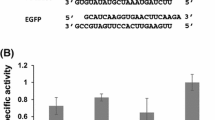Abstract
Glycoproteins have various biological functions including enzymatic activity, protein stability and others. Due to the presence of paucimannosidic N-linked glycans, recombinant proteins from an insect cell expression system may not be suitable for therapeutic use. Because baculovirus expression systems (BESs) are used to produce recombinant proteins, it is of interest to modify the endogenous N-glycosylation pathway in insects to mimic that of mammals. Using a soaking RNAi sensitive cell line, BmN4-SID1, has enabled us to suppress Bombyx mori FDL (BmFDL), an N-linked glycan-specific β-N-acetylglucosaminidase. Western blotting and MALDI-TOF MS demonstrated that the BmFDL depletion almost completely converted the paucimannosidic structures of the recombinant proteins produced by BES into a complex-type structure. This highly efficient, simple and low-cost method can be used for mass production of secretion proteins with complex-type N-linked glycans.





Similar content being viewed by others
References
Bardor M, Faveeuw C, Fitchette AC, Gilbert D, Galas L, Trottein F, Faye L, Lerouge P (2003) Immunoreactivity in mammals of two typical plant glyco-epitopes, core α (1,3)-fucose and core xylose. Glycobiology 13:427–434
Bause E (1983) Structural requirements of N-glycosylation of proteins. Studies with proline peptides as conformational probes. Biochem J 209:331–336
Cattaneo F, Pasini ME, Intra J, Matsumoto M, Briani F, Hoshi M, Perotti ME (2006) Identification and expression analysis of Drosophila melanogaster genes encoding β-hexosaminidases of the sperm plasma membrane. Glycobiology 16:786–800
Delorme E, Lorenzini T, Giffin J, Martin F, Jacobsen F, Boone T, Elliott S (1992) Role of glycosylation on the secretion and biological activity of erythropoietin. Biochemistry 31:9871–9876
Furukawa J, Shinohara Y, Kuramoto H, Miura Y, Shimaoka H, Kurogochi M, Nakano M, Nishimura SI (2008) Comprehensive approach to structural and functional glycomics based on chemoselective glycoblotting and sequential tag conversion. Anal Chem 80:1094–1101
Geisler C, Aumiller JJ, Jarvis DL (2008) A fused lobes gene encodes the processing β-N-actylgucosaminidase in Sf9 cells. J Biol Chem 283:11330–11339
Herscovics A (1999) Importance of glycosidases in mammalian glycoprotein biosynthesis. Biochim Biophys Acta 473:96–107
Kim YK, Kim KR, Kang DG, Jang SY, Kim YH, Cha HJ (2009) Suppression of β-N-acetylglucosaminidase in N-glycosylation pathway for complex glycoprotein formation in Drosophila S2 cells. Glycobiology 19:301–308
Mon H, Kobayashi I, Ohkubo S, Tomita S, Lee J, Sezutsu H, Tamura, Kusakabe T (2012) Effective RNA interference in cultured silkworm cells mediated by overexpression of Caenorhabditis elegans SID-1. RNA Biol 9:40–46
Motohashi T, Shimojima T, Fukagawa T, Maenaka K, Park EY (2005) Efficient large-scale protein production of larvae and pupae of silkworm by Bombyx mori nuclear polyhedrosis virus bacmid system. Biochem Biophys Res Commun 326:564–569
Nalivaeva NN, Turner AJ (2001) Post-translational modifications of proteins: acetylcholinesterase as a model system. Proteomics 1:735747
Nomura T, Ikeda M, Ishiyama S, Mita K, Tamura T, Okada T, Fujiyama K, Usami A (2010) Cloning and characterization of a β-N-acetylglucosaminidase (BmFDL) from silkworm Bombyx mori. J Biosci Bioeng 110:386–391
Oba Y, Shimasaki Y, Oshima Y, Satone H, Kitano T, Nakao M, Kawabata S, Honjo T (2007) Purification and characterization of tributyltin-binding protein type 2 from plasma of Japanese flounder, Paralichthys olivaceus. J Biochem 142:229–238
Okada T, Ishiyama S, Sezutsu H, Usami A, Tamura T, Mita K, Fujiyama K, Seki T (2007) Molecular cloning and expression of two novel β-N-acetylglucosaminidases from silkworm Bombyx mori. Biosci Biotechnol Biochem 71:1626–1635
Renaud L, Rendic D, Rabouille C, Wilson IBH, Preat T, Altmann F (2006) The Drosophila fused lobes gene encodes an N-acetylglucosaminidase involved in N-glycan processing. J Biol Chem 281:4867–4875
Satone H, Lee JM, Oba Y, Kusakabe T, Akahoshi E, Miki S, Suzuki N, Sasayama Y, Nassef M, Shimasaki Y, Kawabata S-I, Honjo T, Oshima Y (2011) Tributyltin-binding protein type 1, a lipocalin, prevents inhibition of osteoblastic activity by tributyltin in fish scales. Aquat Toxicol 103:79–84
Schachter H (2000) The joys of HexNAc. The synthesis and function of N- and O-glycan branches. Glycoconj J 17:465–483
Soejima Y, Lee JM, Nagata Y, Mon H, Iiyama K, Kitano H, Matsuyama M, Kusakabe T (2012) Comparison of signal peptides for efficient protein secretion in the baculovirus-silkworm system. Cent Eur J Biol 8:1–7
Tams JW, Vind J, Welindera KG (1999) Adapting protein solubility by glycosylation. N-Glycosylation mutants of Coprinus cinereus peroxidase in salt and organic solutions. Biochim Biophys Acta 1432:214–221
Tatsuke T, Sakashita K, Masaki Y, Lee JM, Kawaguchi Y, Kusakabe T (2010) The telomere-specific non-LTR retrotransposons SART1 and TRAS1 are suppressed by Piwi subfamily proteins in the silkworm, Bombyx mori. Cell Mol Biol Lett 15:118–133
Varki A (1993) Biological roles of oligosaccharides: all of the theories are correct. Glycobiology 3:97–130
Wang C, Eufemi M, Turano C, Giartosio A (1996) Influence of the carbohydrate moiety on the stability of glycoproteins. Biochemistry 35:7299–7307
Yuen CT, Storring PL, Tiplady RJ, Izquierdo M, Wait R, Gee CK, Gerson P, Lloyd P, Cremata JA (2003) Relationships between the N-glycan structures and biological activities of recombinant human erythropoietins produced using different culture conditions and purification procedures. Brit J Haematol 121:511–526
Acknowledgments
This work was supported in part by KAKENHI Nos. 22248004 and 23580077 from the Japan Society for the Promotion of Science.
Author information
Authors and Affiliations
Corresponding author
Electronic supplementary material
Below is the link to the electronic supplementary material.
Rights and permissions
About this article
Cite this article
Nagata, Y., Lee, J.M., Mon, H. et al. RNAi suppression of β-N-acetylglucosaminidase (BmFDL) for complex-type N-linked glycan synthesis in cultured silkworm cells. Biotechnol Lett 35, 1009–1016 (2013). https://doi.org/10.1007/s10529-013-1183-9
Received:
Accepted:
Published:
Issue Date:
DOI: https://doi.org/10.1007/s10529-013-1183-9




